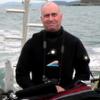
Invasive Exotics and Local Politics
#1

Posted 08 February 2007 - 09:37 PM
I wasn't prepared for the politics emerging around a plan I put together to remove an invasive Japanese alga (Sargassum filicinum) that arrived on the island last April and has colonized most sites along the leeward coast. All I wanted to do was remove the alga from our local city dive park. I've always been told by the City that it is up to the local divers to maintain the park, so I proceded.
This Asian exotic (natrive to Japan and Korea was probably able to spread so quickly due to the absence of giant kelp canopy during our extreme warm water episode last summer and fall. Wothout the shading by the giant kelp canopy, it had plenty of sunlight to photosynthesize and grow. I am hopeful that if we remove this annual, it will increase light levels at the substrate level and allow young giant kelp (Macrocystis) to grow in its place (where it dominated before this invasion) and shade out the Sargassum next growing season.
I arranged for a small group of divers and volunteers to come over to the park tomorrow to finish removing the Sargassum from an area just off the dive park stairs. I will then video monitor this test removal site to see if the native Macrocystis does indeed recover its former dominance. My desire is to at least control it in the dive park and see if we might spread the removal effort to other sites next season.
Little did I anticipate the political concerns expressed by folks in Avalon. The concerns focus around whether it is a good idea to remove it at all; whether removing it and running the wet biomass through the composting machinery at our landfill site will cause it to spread; who will cover the cost of disposing of the wet biomass; etc.
What I have proposed as a test removal method is to have a group of three volunteers at the park tomorrow follow this procedure: (1) clip the Sargassum filicinum at the very base of the holdfast (minimizing agitation of the plants); (2) towing the clipped plants to the dive stairs; (3) having a land-based volunteer drag the plants up to the parking area where they will be bagged for pick up; and (4) having the removed plants disposed of in the green waste (compost area) at the landfill.
Although we may never control this species island-wide, I think it is an important idea ecologically and educationally to remove it from the park itself. I'd certainly like to see the giant kelp return to its former levels, and I doubt it can in the presence of the Sargassum.
As for potential release of reproductive structures into the nearshore waters below the dump site due to mechanically tearing the plants up, I can't see this as a significant problem compared to leaving it to grow in the park. In addition, the Sargassum is already well established in the waters below the dump based on dives I've done in those waters over the past 6-8 months.
Mayor Bob Kennedy has said he will do everything he can to support this effort. He and his wife Tina are divers and own SCUBA Luv dive shop. Ultimately we will succeed in getting this effort underway
However, I can't believe the (minor) political issue this has become! Oh, that's right... life in a small town in the middle of winter and the off-season. I forgot!
#2

Posted 09 February 2007 - 12:45 AM
#3

Posted 09 February 2007 - 12:54 AM
I admit I only skimmed your post, but personally, I applaud the residents for taking an interest in this project re: disposal, contamination, etc. So many people are apathetic about their environment. Good luck with this, Bill!
Caetllonn, I don't think they are really that interested in the project in the least. Just in exercising "control." It is the divers from the mainland who are really interested in controlling the invasive. I haven't had a single volunteer from the island yet, other than the Mayor's indication of his support (which I greatly appreciate).
#4

Posted 09 February 2007 - 01:30 AM
Oh. Good luck anyway.I admit I only skimmed your post, but personally, I applaud the residents for taking an interest in this project re: disposal, contamination, etc. So many people are apathetic about their environment. Good luck with this, Bill!
Caetllonn, I don't think they are really that interested in the project in the least. Just in exercising "control." It is the divers from the mainland who are really interested in controlling the invasive. I haven't had a single volunteer from the island yet, other than the Mayor's indication of his support (which I greatly appreciate).
#5

Posted 09 February 2007 - 10:09 PM
We have the same thing going on up here with the Invasive Tunitcates and various dive groups cleaning it off...
Best idea is to get the Bios involved... so they can back it up...
Good luck...
Pics of one type of Tunicate
Edited by fbp, 09 February 2007 - 10:11 PM.
#6

Posted 10 February 2007 - 12:49 AM
Best idea is to get the Bios involved... so they can back it up...
Good luck...
If by Bios, you mean marine biologists, I'm an internationally published research biologist specializing in marine algae and one of the few experts on the marine life of Catalina.
Sorry to hear about the tunicates. We will be seeing more and more of these biological invasions as long as trans-Pacific trade continues without sufficient restrictions and verification. Of course Asian ports in South Korea, Japan, China and Taiwan are probably experiencing the same thing with our invasive "exotics" (from their perspective).
#7

Posted 10 February 2007 - 09:45 AM
Sorry Bill, didn't realize, thought you were strictly in the video arena....If by Bios, you mean marine biologists, I'm an internationally published research biologist ...
There seems to be more enthusiasm with the Student Bios (Biologists) that have the invasive species as their projects or the like. The last 2 people that were active were the students and although they disappear for the summers and when they graduate, the do actively support and encourage the diving community by setting up dives specific to their project....
Just a thought. Other than that we have a few REEF ID people, Janna Nichols - friend of Nicolle the "Dive_Girl" here at SD, that are actively setting up dives like the one I referred to in the above link... I just try to photograph them when I see something that looks like the ones we're looking for and then let them know... most of the time it's a local species... sponge etc.. but I keep on trying...
Most of the ones that I got on that pager were up in Canada, which is heavily hit... and surprisingly out of the main shipping lanes to Vancouver... Powell River, Sunshine Coast etc...
Anyway, happy hunting...
Edited by fbp, 10 February 2007 - 10:07 AM.
#8

Posted 10 February 2007 - 02:39 PM
Rick
#9

Posted 10 February 2007 - 06:03 PM
Interesting. Here on the East Coast, Sargassum is a floating seaweed that doesn't attach, so it's not competitive with benthic algae. In fact, it's found in large quantities in an area called the Sargasso Sea, which is so far offshore that benthic algae would be out of the photosynthetic zone.
Rick
Familiar with yours, Rick.
We have several species here, both exotic and native, that are benthic. Just finished a few dives in the park and the d*()I$^%#^%*& stuff is colonizing deeper water out to 70' (its normal range is down to 40' but I think our clearer water allows more sunlight at depth so they can exceed their normal range).
1 user(s) are reading this topic
0 members, 1 guests, 0 anonymous users














